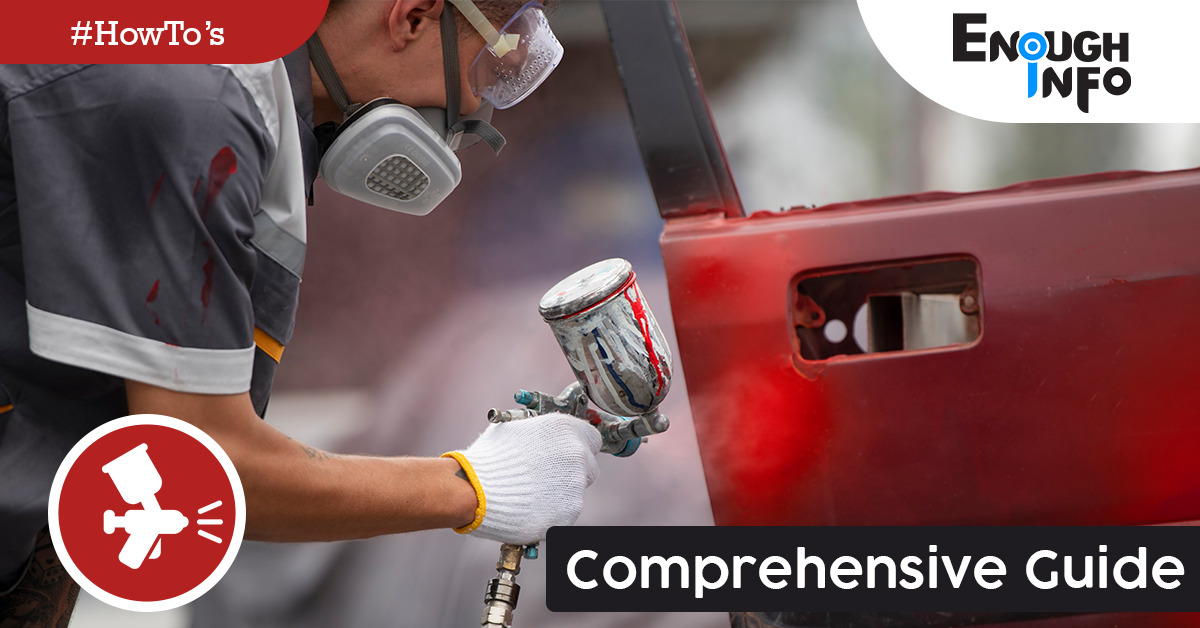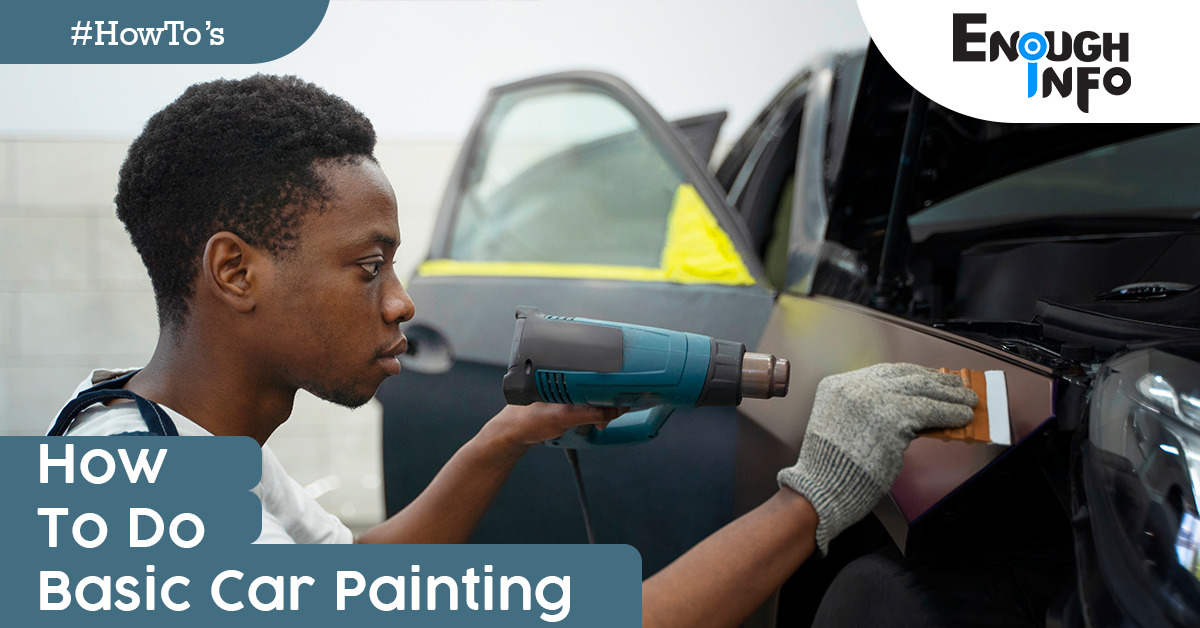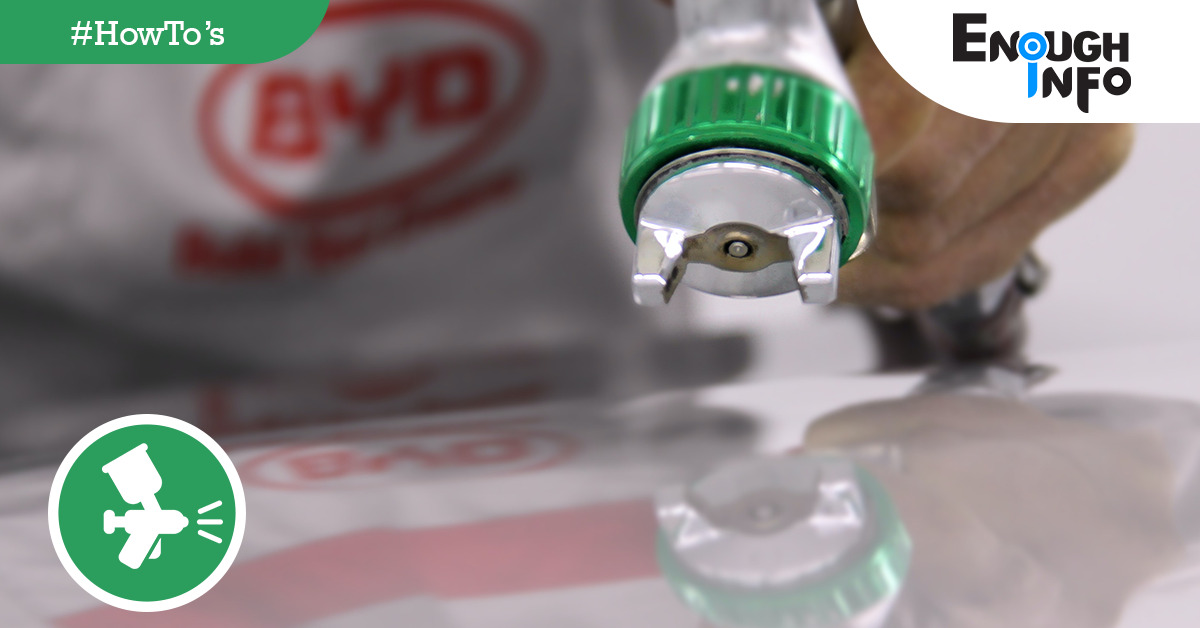
How To Do Basic Car Painting: Car painting is not just about aesthetics; it also plays a vital role in protecting the vehicle’s exterior from rust, corrosion, and damage. While professional car painting requires expertise and specialized equipment, basic car painting techniques can be learned and executed by enthusiastic car owners. EnoughInfo.com

Read Also: How To Do Basic Car Detailing
A new coat of paint can drastically improve a car’s appearance. It may restore a worn-out or faded exterior, conceal scratches and flaws, and give the vehicle a rejuvenated and polished appearance. Most importantly, a well-maintained and properly painted car has a greater resale value. Prospective buyers are frequently prepared to pay extra for a vehicle that appears clean, well-maintained, and has an appealing paint finish. How To Create A Budget For Traveling
Overall, basic automobile painting is crucial for enhancing the appearance, safeguarding the vehicle, preserving its worth, and letting car owners fully personalise and enjoy their vehicles. Learning how to do basic automobile painting may be a vital skill for any car enthusiast or owner, whether for aesthetic purposes, preservation, or personal gratification.
FAQs & Answers on How To Do Basic Car Painting
1. How long does the car painting process take?
The duration of the car painting process can vary depending on factors such as the size of the vehicle, the extent of surface preparation required, the number of coats, and drying times. Generally, it can take several days to complete the entire process, allowing for proper drying between coats. How To Make A DIY Face Mask For Glowing Skin
2. What is the difference between enamel, acrylic, and urethane paints?
Enamel, acrylic, and urethane are different types of automotive paint. Enamel is a durable, solvent-based paint known for its glossy finish and resistance to chips and scratches. Acrylic paint is water-based and offers ease of use, quick drying time, and good color retention. Urethane paint provides excellent durability, UV resistance, and a high-gloss finish.
3. How do I choose the right color for my car?
Choosing the right color for your car is a personal preference. Consider factors such as your style, the overall aesthetic you want to achieve, and the resale value. It’s recommended to obtain color swatches or samples, test them in different lighting conditions, and visualize how they will look on your vehicle before making a final decision.
Read Also: How To Be A Better Decision Maker (10 Good Tips)
4. How do I prevent overspray and protect surrounding areas during painting?
To prevent overspray and protect surrounding areas during painting, use masking tape and plastic sheets to cover areas you don’t want to paint. Ensure that the plastic sheets are secured tightly to prevent them from flapping or moving during the painting process.
5. How long should I wait between coats of paint?
The waiting time between coats of paint depends on the specific paint product and manufacturer’s instructions. It’s crucial to allow each coat to dry fully before applying the next coat. Typically, waiting times can range from 15 minutes to a few hours, but it’s best to refer to the paint can for specific recommendations.
6. How can I maintain the paint job after it’s done?
To maintain the paint job, regularly wash your car using a pH-neutral car shampoo and a soft sponge or microfiber cloth. Avoid abrasive cleaners or brushes that could damage the paint. Additionally, apply a high-quality automotive wax to protect the paint from UV rays, oxidation, and environmental contaminants.
7. Can I fix paint defects and imperfections after the paint has dried?
Yes, paint defects and imperfections can be fixed even after the paint has dried. Techniques such as wet sanding, polishing, and localized touch-ups can be used to address issues like orange peel, runs, fisheyes, and dust particles.
8. Do I need to use a clear coat after the base coat?
It is highly recommended to apply a clear coat after the base coat. The clear coat provides an additional layer of protection, enhances the shine and depth of the paint, and improves the overall durability of the finish.
9. Can I paint over existing paint on my car?
Yes, you can paint over existing paint on your car. However, it is important to ensure that the surface is properly prepared by cleaning, sanding, and removing any loose or damaged paint.
Read Also: How To Do Basic Car Repairs(Ultimate Guide)
A Comprehensive Guide to Basic Car Painting Techniques

In this comprehensive guide, we will walk you through the step-by-step process of basic car painting, covering everything from surface preparation to final polishing. Whether you’re looking to refresh the look of your car or tackle small touch-up jobs, this article will provide you with the knowledge and confidence to achieve satisfying results. How To Teach A Parrot To Talk
1. Importance of Surface Preparation
Before diving into the car painting process, it is crucial to emphasize the significance of proper surface preparation. Neglecting this step can lead to subpar results and paint failure in the long run. Here are the key aspects of surface preparation:
-
Washing and Drying the Car
Start by thoroughly washing the vehicle to remove dirt, grime, and any contaminants that may affect paint adhesion. Use a car-specific soap and a soft sponge or microfiber cloth. Rinse the car thoroughly and dry it completely to prevent water spots or residue.
-
Removing Rust and Old Paint
Inspect the car for any signs of rust or chipped paint. Use sandpaper or a wire brush to remove rust from affected areas. For old paint, use sandpaper or a paint stripper to create a smooth surface for the new paint to adhere to. Be sure to follow safety guidelines when working with paint strippers and wear appropriate protective gear. How To Play The Flute For Beginners
-
Sanding the Surface
Sanding the car’s surface helps create a smooth and even base for the paint. Use sandpaper with varying grits, starting with a coarser grit to remove imperfections and gradually moving to finer grits for a smoother finish. Sand in a circular or back-and-forth motion, paying attention to areas with uneven texture or scratches. After sanding, clean the surface to remove dust and debris.
2. Choosing the Right Paint and Equipment
Selecting the appropriate paint and equipment is crucial for achieving professional-looking results. Consider the following factors:
-
Types of Automotive Paint
There are different types of automotive paint, including enamel, acrylic, and urethane. Each has its own advantages and application methods. Research and choose a paint type that suits your preferences, budget, and skill level.
-
Spray Guns and Compressors
Investing in a good-quality spray gun and compressor is essential for achieving smooth and even paint application. Choose a spray gun with adjustable controls and a nozzle suitable for the type of paint you’re using. The compressor should provide sufficient airflow and pressure for optimal atomization.
-
Protective Gear and Supplies
Ensure you have the necessary protective gear, including goggles, gloves, and a respirator mask, to protect yourself from harmful fumes and particles. Additionally, gather supplies such as masking tape, plastic sheets, mixing cups, and stirring sticks to facilitate the painting process. How To Clean Grout Between Tiles
3. Preparing the Workspace
Creating an appropriate workspace is essential to ensure a safe and controlled environment for car painting. Consider the following factors when preparing your workspace:
Read Also: How To Do A Basic Car Maintenance Check
-
Ventilation and Safety Measures
Ensure proper ventilation in the area where you’ll be painting to prevent the buildup of fumes and ensure fresh air circulation. Open windows, use fans, or work in a well-ventilated garage. If possible, wear a respirator mask to filter out airborne particles and chemicals.
-
Setting Up the Work Area
Clear the space of any obstacles or items that could interfere with the painting process. Cover the floor and surrounding areas with plastic sheets to protect against overspray. Create a designated area for paint mixing and preparation, ensuring all supplies are within easy reach.
4. Applying Primer
Primer is an essential step in the car painting process as it helps improve paint adhesion and provides a smooth base for the color coat. Follow these steps to apply primer effectively:
-
Importance of Primer
Primer fills in small imperfections, creates a consistent surface, and enhances paint durability. It also acts as a barrier, preventing corrosion and promoting long-lasting paint adherence. How To Start A Successful Blog
-
Mixing and Applying Primer
Follow the manufacturer’s instructions for mixing the primer. Use a paint mixing cup and stir stick to ensure the primer is well-blended. Pour the primer into the spray gun’s container, making sure to strain it to remove any impurities.
Start applying the primer in even, overlapping passes, holding the spray gun about 6-8 inches away from the surface. Apply multiple thin coats rather than a single thick coat to avoid drips and achieve better adhesion. Allow each coat to dry according to the manufacturer’s recommended drying time before applying the next coat.
-
Sanding the Primer
After the final coat of primer has dried, use fine-grit sandpaper or a sanding block to smooth out any imperfections or uneven areas. This step is crucial to achieve a flawless finish. Sand lightly in a circular or back-and-forth motion, focusing on areas that may need extra attention. Wipe away any dust or debris with a clean cloth before proceeding to the next stage.
5. Applying Base Coat
The base coat is where you apply the actual color to your car. It requires precision and careful application to achieve the desired result. Follow these steps when applying the base coat:
-
Mixing and Preparing Base Coat
Refer to the manufacturer’s instructions to properly mix the base coat paint. Use a paint mixing cup and stir stick to ensure a consistent color. Strain the paint to remove any impurities before pouring it into the spray gun’s container.
-
Proper Techniques for Applying Base Coat
Hold the spray gun about 6-8 inches away from the surface and apply the base coat using smooth, even passes. Start from one end of the car and work your way to the other, overlapping each pass slightly to ensure even coverage. Apply multiple thin coats, allowing the paint to dry between coats. Be patient and take your time to achieve an even and uniform color.
-
Drying and Sanding the Base Coat
Once the base coat has been applied and has dried according to the manufacturer’s instructions, inspect the surface for any imperfections. If needed, use fine-grit sandpaper or a sanding block to smooth out any rough spots or dust particles. Be cautious and gentle to avoid sanding through the base coat.
Read Also: How To Unlock A Car Door With Power Locks
6. Applying Clear Coat
The clear coat provides the final protective layer and adds gloss and depth to the paint job. Follow these steps for applying the clear coat: How To Paint A Still Life With Watercolors
-
Understanding Clear Coat
Clear coat is a transparent layer that protects the underlying paint and provides a glossy finish. It acts as a barrier against UV rays, oxidation, and environmental elements. Make sure to choose a high-quality clear coat for optimal results.
-
Applying Clear Coat for a Smooth Finish
Mix the clear coat according to the manufacturer’s instructions and strain it to remove any impurities. Apply thin, even coats of clear coat, following the same techniques used for the base coat. Work in a methodical and systematic manner, ensuring complete coverage. Allow each coat to dry before applying the next. How To Organize A Home Office
-
Buffing and Polishing the Clear Coat
After the final coat of clear coat has dried, the surface may appear slightly dull or have minor imperfections. Use a buffer or polisher with a foam pad and a polishing compound to restore the shine and smoothness of the clear coat. Work in small sections, applying moderate pressure and using circular motions. Wipe away any residue and inspect the finish for any remaining imperfections.
Dealing with Paint Defects and Imperfections

Despite your best efforts, there may be instances where paint defects or imperfections occur during the car painting process. Here are some common paint defects and solutions to address them:
Common Paint Defects and Solutions
- Orange Peel: This refers to a textured surface resembling the skin of an orange. It can occur due to improper paint application or insufficient drying time between coats. To fix orange peel, wet sand the affected area with fine-grit sandpaper and then polish it to restore smoothness.
- Runs and Drips: Runs and drips happen when excessive paint is applied in a single area, causing it to sag or drip. To fix this, wait for the paint to dry completely, sand down the affected area gently, and then apply additional coats of paint, following the proper techniques. How to make a vegan dessert
- Fish Eyes: Fish eyes are small, crater-like imperfections that occur when contaminants such as silicone or oil are present on the surface. Clean the affected area thoroughly, sand it lightly, and apply a fresh coat of paint to eliminate fish eyes.
- Dust and Debris: Dust and debris can settle on the painted surface, creating rough spots. To remove dust and debris, wait for the paint to dry completely, sand the affected area lightly, and apply another coat of paint.
Sanding and Polishing Techniques for Flawless Results
When addressing paint defects, sanding and polishing play crucial roles in achieving a flawless finish. Use various grits of sandpaper, starting from a coarser grit and progressing to a finer grit, to smooth out imperfections. Follow up with a polishing compound and a foam pad to restore the shine and luster of the paint.
Blending and Feathering for Touch-Up Jobs
For small touch-up jobs or areas that require localized repairs, blending and feathering techniques are essential to ensure a seamless transition between the new and existing paint. These techniques involve carefully feathering the paint and blending the edges to achieve a natural and unnoticeable repair.
Read Also: How To Paint A Still Life With Watercolors
Cleaning and Maintaining Painted Surfaces
To prolong the life and appearance of your freshly painted surfaces, proper cleaning and maintenance are essential. Here are some tips to keep your painted surfaces in top condition:
-
Proper Cleaning Techniques
Use a pH-neutral car shampoo and a soft sponge or microfiber cloth to wash your car. Avoid abrasive cleaners or brushes that can damage the paint. Rinse thoroughly and dry with a clean, lint-free cloth to prevent water spots.
-
Waxing and Protecting the Paint
Applying a high-quality automotive wax helps protect the paint from UV rays, oxidation, and environmental contaminants. Wax your car regularly, following the manufacturer’s instructions. This not only adds a protective layer but also enhances the shine and depth of the paint.
Safety Precautions
When undertaking any car painting project, it is crucial to prioritize safety. Here are some safety precautions to follow:
-
Personal Protective Equipment (PPE)
Wear safety goggles, gloves, and a respirator mask to protect yourself from fumes, chemicals, and airborne particles. Ensure proper ventilation in your workspace and take breaks if you feel lightheaded or dizzy.
-
Safe Handling and Disposal of Chemicals
Follow the manufacturer’s instructions when handling and storing paint, primers, solvents, and other chemicals. Dispose of any leftover materials and empty containers in accordance with local regulations.
Tips and Tricks for Successful Car Painting
To ensure successful car painting, consider the following tips and tricks:
-
Practice on Scrap or Test Panels
Before applying paint to your car, practice on scrap or test panels to familiarize yourself with the techniques, equipment, and paint consistency required for a smooth application. This allows you to gain confidence and refine your skills before working on the actual car.
-
Take Your Time and Work in a Controlled Environment
Car painting requires patience and attention to detail. Rushing through the process can lead to mistakes and unsatisfactory results. Set aside enough time for each step and ensure you’re working in a controlled environment with proper lighting and ventilation.
-
Seek Professional Help When Needed
While basic car painting can be done as a DIY project, there may be instances where professional expertise is required. If you encounter complex paint repairs, extensive damage, or if you feel unsure about certain aspects of the process, it’s wise to consult or hire a professional auto body shop. They have the experience, tools, and knowledge to deliver exceptional results.
Read Also: How To Make Lime Green Paint(2023Guide)
Conclusion
Basic car painting is an exciting and rewarding endeavor that allows you to enhance the appearance of your vehicle. By following the step-by-step process outlined in this comprehensive guide, you can achieve impressive results. Remember the importance of surface preparation, the selection of quality materials and equipment, and the application techniques required for each coat. Additionally, prioritize safety precautions and proper cleaning and maintenance to keep your painted surfaces looking their best. With patience, practice, and attention to detail, you’ll be able to transform your car’s exterior and enjoy the satisfaction of a professional-looking paint job.
Recommended;
How to Get Spray Paint off Skin
How to remove paint from clothes (2023 Review)
The Benefits Of A Minimalist Lifestyle And How To Adopt It




